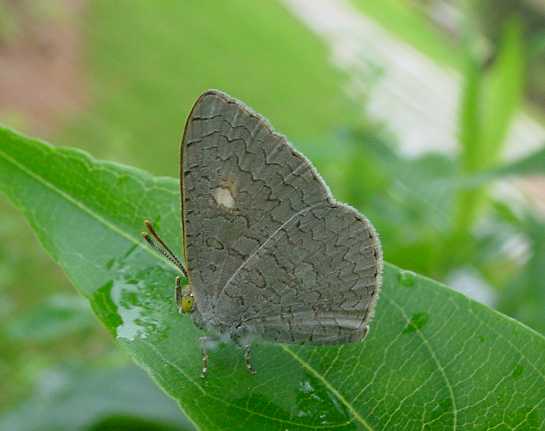- Spalgis epius
Taxobox
name = Apefly

image_width = 250px
image_caption =
regnum =Animal ia
phylum =Arthropod a
classis =Insect a
ordo =Lepidoptera
superfamilia =Papilionoidea
familia =Lycaenidae
subfamilia =Miletinae
genus = "Spalgis "
species = "S. epius"
binomial = "Spalgis epius"
binomial_authority = (Westwood, 1851)The Apefly ("Spalgis epius") is a small
butterfly found inAsia that belongs to the Lycaenids or Blues family. [http://www.nic.funet.fi/pub/sci/bio/life/insecta/lepidoptera/ditrysia/papilionoidea/lycaenidae/miletinae/spalgis/index.html Page on Marrku Savela's site for genus Spalgis (Lycaenidae).] ] It gets its name from the supposed resemblance of its caterpillar to the face of an ape.Description
Male
Upperside: dull brown, slightly darker towards the apex of the fore wing; also a more or less quadrate whitish spot beyond the apex of the cell on the same wing; in some specimens this spot is slightly diffuse. Underside : pale, silky, brownish-white; fore and hind wings crossed by numerous, very slender, short, sinuous, transverse, dark brown strigae which are outwardly slenderly edged with brownish-white of a shade paler than that of the ground-colour; both wings with an anticiliary dark brown line with on the inner side a similar edging. Fore wing, in addition, with an oval white spot beyond the cell. Cilia of both fore and hind wings of the same shade as the ground-colour of the wings. Antenna, head, thorax and abdomen pale brown, club of antennae ochraceous at apex; beneath : the palpi and thorax brownish-grey, abdomen pale brown.
Female
Upperside: slightly paler brown. Fore wing: the cell and apex darker; a white spot similar to that in the male but larger, beyond the apex of the cell; in most specimens extended diffusely outwards and downwards. Hind wing: similar to that of the male. Underside: precisely as in the male. [Bingham, C. T. (1907) Fauna of British India. Butterflies. Volume 2.]
Life cycle
The caterpillars of this butterfly like other members of the subfamily
Miletinae areentomophagous and are predators ofscale insect s. [Venkatesha, M. G., L. Shashikumar, S.S.Gayathri Devi (2004) Protective devices of the carnivorous butterfly, "Spalgis epius" (Westwood) (Lepidoptera: Lycaenidae) Current Science 87(5): 571-572 [http://www.ias.ac.in/currsci/sep102004/571.pdf PDF] ] The species unlike many other lycaenid butterflies is not myrmecophilous. [Venkatesha, M. G. (2005) Why is homopterophagous butterfly, "Spalgis epius" (Westwood) (Lepidoptera: Lycaenidae) amyrmecophilous? Current Science 89(2):245-246 [http://www.ias.ac.in/currsci/jul252005/245.pdf PDF] ]Cited references
References
* Evans, W.H. (1932) The Identification of Indian Butterflies. (2nd Ed), Bombay Natural History Society, Mumbai, India
* Gaonkar, Harish (1996) Butterflies of the Western Ghats, India (including Sri Lanka) - A Biodiversity Assessment of a threatened mountain system. Journal of the Bombay Natural History Society.
* Haribal, Meena (1994) Butterflies of Sikkim Himalaya and their Natural History.
* Kunte,Krushnamegh (2005) Butterflies of Peninsular India. Universities Press.
* Wynter-Blyth, M.A. (1957) Butterflies of the Indian Region, Bombay Natural History Society, Mumbai, India.ee also
*
List of butterflies of India (Lycaenidae) External links
* [http://www.asahi-net.or.jp/~EY4Y-TKNM/philframe.html Asahi] Correctly determined photos of "Spalgis epius"
Wikimedia Foundation. 2010.
